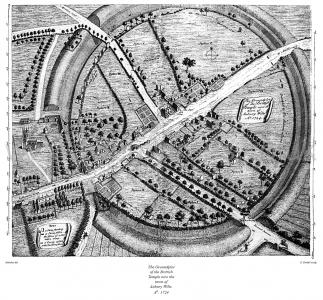Avebury A Temple of British Druids, With Some Others, Described by William Stukeley
Avebury A Temple of British Druids, With Some Others, Described by William Stukeley is in Prehistory.
by William Stukeley (age 36), M.D. Rector of All-Saints [Map] in Stamford.
1724. Table I. Frontspiece. The Groundplot of the Brittish Temple now the town of Aubury Wilts. Ao. 1724. [Note. This drawing shows the location of a number of stones that were destroyed and the year in which they were destroyed. Curiously it shows the outer circle and inner north circle as being composed on two rings of stones rather than the one ring we presume today. Also interesting is that there is a note on the east entrance staying 'road to Marlborough' - this being the route to the Ridgeway.]

Wherein is a more particular account of the first and patriarchal religion; and of the peopling the British Islands.
Quamvis obstet mihi tarda vetustas, Multaque me fugiant primis spectata sub annis, Plura tamen memini - Ov. Met. XII. v. 182.
[Although old age hinders me, And many things shun me at first sight under the years, However, I remember more, or, Though the slowness of age hampers me, and many things I once saw have slipped from me, I can still remember many, or, "Although my great age is a harm to me, and many actions of my early days escape my memory; yet, most of them are well remembered.]
Wessex from the Air Plate 36. Literary References
John Aubrey, Mon. Brit. (Bodleian Library, Oxford); plan of Avebury made 1663; reproduced in facsimile in W.A.M., vol. vii.
Willaim Stukeley, Abury, a temple of the British Druids, 1743.
William Long, ‘Abury Wiltshire Archaeological Magazine, vol. iv (January 1858), pp. 309-63. (This is by far thebest existing account of Avebury.)
Facsimiles of Aubrey’s plans of Avebury, and corrigenda of preceding paper; W.A.M. vii (December 1861) ,pp, 224—6.
The Rev, A, C. Smith, 'Excavations at Avebury W,A.M, x (January 1867), pp. 209-16. (An account of excavations made there by Mr. Smith, associated with Messrs. W. G. Lukis, W. Cunnington, and King, 29th September to 5th October 1865. Excavations were made in the Northern Inner Circle, near and also within the Cove itself, in the mound or embankment to the south-east, in the Southern Circle, and through the Great Outer Bank.)
William Long, 'Abury Notes’, W.A.M. xvii (March 1878), pp. 327-35. (Valuable notes on lost, buried, or destroyed stones in the circles and avenues, especially the Kennet Avenue.)
The Rev. Bryan King, Vicar of Avebury, ‘Avebury— The Beckhampton Avenue’, W.A.M. xviii (November 1879), pp. 377-83. (A vigorous defence of the Beckhampton Avenue, supported by evidence.)
‘A buried stone in the Kennet Avenue’, W.A.M. xxxviii (June 1913), pp. 12—14.
H. St. George Gray, Reports on Excavations at Avebury; published in the Reports of the British Association for the years 1908 (401-11), 1909 (271-84), 1911 (141-52), 1915 (174-89), 1922 (326-33).